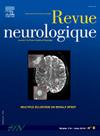Autosomal dominant distal myopathy due to p.Ser85Cys mutation in the MATR3 gene: Novel case series and literature review
IF 2.3
4区 医学
Q2 CLINICAL NEUROLOGY
引用次数: 0
Abstract
Introduction
Matrin-3 autosomal dominant myopathy, most commonly caused by a Ser85Cys (S85C) missense mutation, is a rare distal myopathy, presenting a heterogeneous phenotype.
Methods
We report the clinical, physiological, radiological, and histological features of the first Portuguese patients diagnosed with p.Ser85Cys MATR3-related myopathy using a specific gene panel dedicated to “distal myopathies”. Additionally, a narrative review of the literature was performed to contextualize our findings within the broader landscape of MATR3-related pathologies.
Results
Our case series describes the clinical findings of three patients diagnosed and followed in our center. The first patient was a 57-year-old male presenting with lower limb weakness, followed by loss of muscle force for fine motor gestures in the distal upper limb. Neurological examination revealed important muscle atrophy of the distal limbs and symmetrical motor deficit. The second patient, the brother of the aforementioned subject, was a 54-year-old male with similar symptoms associated with dysphagia and dysphonia. The third patient was a 58-year-old female, unrelated to the previous patients, presenting with distal weakness in the upper limbs and severe Achillean contractures. All three patients were investigated using needle electromyography and whole-body magnetic resonance imaging that disclosed a fatty infiltration pattern in the gastrocnemius, soleus, and tibialis anterior muscles. A muscle biopsy was performed solely for one patient and revealed rimmed vacuoles, consistent with previous reports. Genetic analysis found the same mutation in all three cases: c.254C>G, p.Ser85Cys in the MATR3 gene. The literature review included nine articles reporting families diagnosed with the p.Ser85Cys mutation in the MATR3 gene, and the main phenotypes associated with this genetic variant.
Conclusion
Despite being a rare myopathy, with only a few cases reported, MATR3 gene mutations should be considered in patients with distal myopathy and rimmed vacuoles on muscle biopsy.
常染色体显性远端肌病由于p.s ser85cys突变在mat3基因:新病例系列和文献综述。
matrix -3常染色体显性肌病是一种罕见的远端肌病,最常由Ser85Cys (S85C)错义突变引起。方法:我们使用专门用于“远端肌病”的特定基因面板,报告了第一批被诊断为p.s ser85cys mat3相关肌病的葡萄牙患者的临床、生理、放射学和组织学特征。此外,我们对文献进行了叙述性回顾,将我们的发现与更广泛的mat3相关病理背景联系起来。结果:我们的病例系列描述了在我们中心诊断和随访的三名患者的临床表现。第一位患者为一名57岁男性,表现为下肢无力,随后上肢远端精细运动手势肌肉力量丧失。神经学检查显示远端肢体重要肌肉萎缩和对称运动缺陷。第二例患者为上述受试者的兄弟,54岁男性,症状与吞咽困难和发音困难相似。第三例患者为58岁女性,与之前的患者无关,表现为上肢远端无力和严重的跟腱挛缩。所有三名患者均采用针肌电图和全身磁共振成像进行调查,发现腓肠肌、比目鱼肌和胫前肌中有脂肪浸润。仅对一名患者进行了肌肉活检,发现有边缘空泡,与先前的报道一致。遗传分析发现在所有三个病例中都有相同的突变:c.254C>G, p.Ser85Cys在MATR3基因中。文献综述包括9篇报道被诊断为mat3基因p.Ser85Cys突变的家庭,以及与该基因变异相关的主要表型的文章。结论:尽管是一种罕见的肌病,只有少数病例报道,但在远端肌病和边缘空泡的肌肉活检患者中,应考虑MATR3基因突变。
本文章由计算机程序翻译,如有差异,请以英文原文为准。
求助全文
约1分钟内获得全文
求助全文
来源期刊

Revue neurologique
医学-临床神经学
CiteScore
4.80
自引率
0.00%
发文量
598
审稿时长
55 days
期刊介绍:
The first issue of the Revue Neurologique, featuring an original article by Jean-Martin Charcot, was published on February 28th, 1893. Six years later, the French Society of Neurology (SFN) adopted this journal as its official publication in the year of its foundation, 1899.
The Revue Neurologique was published throughout the 20th century without interruption and is indexed in all international databases (including Current Contents, Pubmed, Scopus). Ten annual issues provide original peer-reviewed clinical and research articles, and review articles giving up-to-date insights in all areas of neurology. The Revue Neurologique also publishes guidelines and recommendations.
The Revue Neurologique publishes original articles, brief reports, general reviews, editorials, and letters to the editor as well as correspondence concerning articles previously published in the journal in the correspondence column.
 求助内容:
求助内容: 应助结果提醒方式:
应助结果提醒方式:


